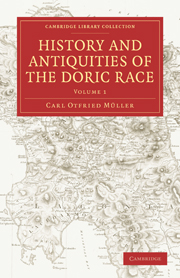Book contents
- Frontmatter
- THE TRANSLATORS' PREFACE
- Contents
- INTRODUCTION
- BOOK I HISTORY OF THE DORIC RACE, FROM THE EARLIEST TIMES TO THE END OF THE PELOPONNESIAN WAR
- BOOK II RELIGION AND MYTHOLOGY OF THE DORIANS
- CHAP. I
- CHAP. II
- CHAP. III
- CHAP. IV
- CHAP. V
- CHAP. VI
- CHAP. VII
- CHAP. VIII
- CHAP. IX
- CHAP. X
- CHAP. XI
- CHAP. XII
- APPENDIX
- ADDITIONS AND CORRECTIONS
- Plate section
CHAP. VI
Published online by Cambridge University Press: 05 August 2011
- Frontmatter
- THE TRANSLATORS' PREFACE
- Contents
- INTRODUCTION
- BOOK I HISTORY OF THE DORIC RACE, FROM THE EARLIEST TIMES TO THE END OF THE PELOPONNESIAN WAR
- BOOK II RELIGION AND MYTHOLOGY OF THE DORIANS
- CHAP. I
- CHAP. II
- CHAP. III
- CHAP. IV
- CHAP. V
- CHAP. VI
- CHAP. VII
- CHAP. VIII
- CHAP. IX
- CHAP. X
- CHAP. XI
- CHAP. XII
- APPENDIX
- ADDITIONS AND CORRECTIONS
- Plate section
Summary
On the double character of Apollo as a punishing and avenging, and also as a healing and protecting deity. On the meaning and etymology of his different titles of Apollo, Phœbus, Pœan, Agyieus, and Lyceus.
1. Homer, as we have already seen, had, both from hearsay and personal observation, acquired a very accurate knowledge of the Cretan worship of Apollo in the Smintheum, in the citadel of Troy, in Lycia near mounts Ida and Cragus, as well as of Pytho and the Delian palm-tree. His picture of Apollo is, however, considerably changed by the circumstance of the god acting as a friend to the Trojans and an enemy to the Greeks, although both equally honour him with sacrifices and pæans. Yet he generally appears to the Greeks in a darker and more unfavourable view. “Dread the son of Jupiter,” says the priest of Chryse to the Greeks, “he walks dark as night; the sure and deadly arrows rattle on his shoulders.” His punishments are sudden sickness, rapid pestilence, and death, the cause and occasion of which is generally unseen; yet sometimes he grants death as a blessing. His arrows are said to wound from afar, because they are unforeseen and unexpected. He is called the far-darting god; his divine vengeance never misses its aim.
- Type
- Chapter
- Information
- History and Antiquities of the Doric Race , pp. 314 - 330Publisher: Cambridge University PressPrint publication year: 2010First published in: 1830



